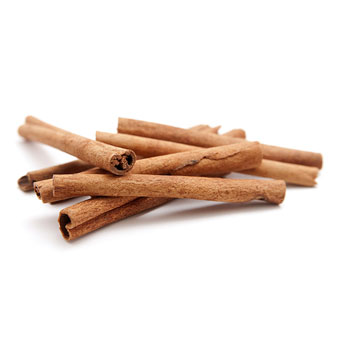Bae WY, Choi JS, Jeong JW International Journal of Molecular Sciences, 2018 ABSTRACT: Cinnamic aldehyde (CA), a key flavor compound in cinnamon essential oil, has been identified as an anti-oxidant, anti-angiogenic, and anti-inflammatory material. Recently, the neuroprotective effects of CA have been reported in various neurodegenerative disorders, including Parkinson’s disease (PD). In neurons, autophagy is… Read more »

Cinnamon Essential Oil
- Botanical Name: Cinnamomum zeylanicum
- Alternative Names: Seychelles cinnamon, Ceylon cinnamon
- Botanical Family: Lauraceae
- Primary Constituent: Cinnamaldehyde
- Other Main Constituents: Eugenol, Linalool
- Distillation Method: Steam Distillation
- Plant Part: Bark
Anti-inflammatory effect of cinnamaldehyde and linalool from the leaf essential oil of Cinnamomum osmophloeum Kanehira in endotoxin-induced mice
Lee SC, Wang SY, Li CC, Liu CT Journal of Food and Drug Analysis, 2018 ABSTRACT: Cinnamomum osmophloeum Kanehira is a Taiwan native plant that belongs to genus Cinnamomum and is also known as pseudocinnamomum or indigenous cinnamon. Its leaf is traditionally used by local people in cooking and as folk therapy. We previously demonstrated… Read more »
Antifungal and Anti-Biofilm Activity of Essential Oil Active Components against Cryptococcus neoformans and Cryptococcus laurentii
Kumari P, Mishra R, Arora N, Chatrath A, Gangwar R, Roy P, Prasad R Frontiers in Microbiology, 2017 ABSTRACT: Cryptococcosis is an emerging and recalcitrant systemic infection occurring in immunocompromised patients. This invasive fungal infection is difficult to treat due to the ability of Cryptococcus neoformans and Cryptococcus laurentii to form biofilms resistant to standard antifungal treatment…. Read more »
Chemistry, Antimicrobial Mechanisms, and Antibiotic Activities of Cinnamaldehyde against Pathogenic Bacteria in Animal Feeds and Human Foods
Friedman M Journal of Agricultural and Food Chemistry, 2017 ABSTRACT: Cinnamaldehyde is a major constituent of cinnamon essential oils produced by aromatic cinnamon plants. This compound has been reported to exhibit antimicrobial properties in vitro in laboratory media and in animal feeds and human foods contaminated with disease-causing bacteria including Bacillus cereus, Campylobacter jejuni, Clostridium perfringens, Escherichia… Read more »
In vitro Protoscolicidal Effects of Cinnamomum zeylanicum Essential Oil and Its Toxicity in Mice
Mahmoudvand H, Mahmoudvand H, Oliaee RT, Kareshk AT, Mirbadie SR, Aflatoonian MR Pharmacognosy Magazine, 2017 BACKGROUND: This study investigates the scolicidal effects of Cinnamomum zeylanicum essential oilagainst the protoscoleces of hydatid cysts and its toxicity in the mice model. MATERIALS AND METHODS: Gas chromatography/mass spectroscopy analyses were used to identify the constituents of essential oil. Protoscoleces were treated… Read more »
Antimicrobial activities of gaseous essential oils against Listeria monocytogenes on a laboratory medium and radish sprouts
Lee G, Kim Y, Kim H, Beuchat LR, Ryu JH International Journal of Food Microbiology, 2017 ABSTRACT: The aim of this study was to evaluate the antimicrobial activities of gaseous essential oils (EO gases) against Listeria monocytogenes on the surfaces of a laboratory medium and radish sprouts. We determined the minimal inhibitory concentration (MIC) and minimal lethal… Read more »
Additivity vs Synergism: Investigation of the Additive Interaction of Cinnamon Bark Oil and Meropenem in Combinatory Therapy.
Yang SK, Yusoff K, Mai CW, Lim WM, Yap WS, Lim SE, Lai KS Molecules, 2017 ABSTRACT: Combinatory therapies have been commonly applied in the clinical setting to tackle multi-drug resistant bacterial infections and these have frequently proven to be effective. Specifically, combinatory therapies resulting in synergistic interactions between antibiotics and adjuvant have been the… Read more »
Essential oils showing in vitro anti MRSA and synergistic activity with penicillin group of antibiotics
Uzair B, Niaz N, Bano A, Khan BA, Zafar N, Iqbal M, Tahira R, Fasim F Pakistan Journal of Phamracological Science, 2017 ABSTRACT: This study was planned in order to investigate effective essential oils to inhibit in-vitro growth of Methicillin resistant Staphylococcus aureus (MRSA). In this study using disc diffusion method anti MRSA activity of ten diverse essential… Read more »
Antifungal properties of essential oils for improvement of indoor air quality: a review
Whiley H, Gaskin S, Schroder T, Ross K Reviews on Environmental Health, 2017 ABSTRACT: Concerns regarding indoor air quality, particularly the presence of fungi and moulds, are increasing. The potential for essential oils to reduce, control or remove fungi, is gaining interest as they are seen as a “natural” alternative to synthetic chemical fungicides. This review examines published… Read more »
Selective Essential Oils from Spice or Culinary Herbs Have High Activity against Stationary Phase and Biofilm Borrelia burgdorferi
Feng J, Zhang S, Shi W, Zubcevik N, Miklossy J, Zhang Y Frontiers in Medicine, 2017 ABSTRACT: Although the majority of patients with acute Lyme disease can be cured with the standard 2-4 week antibiotic treatment, about 10-20% of patients continue suffering from chronic symptoms described as posttreatment Lyme disease syndrome. While the cause for this… Read more »
